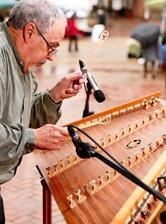There are many different ways we can arrange an exquisitely slow melody!
One option is to mix and match all sorts of techniques for a colorful and interesting presentation.
But sometimes it’s refreshingly different to limit oneself to only one technique.
I wouldn’t usually think of using four-note chord rolls twice in every single measure of a tune, but when I came to the wonderful Welsh air ‘All Through the Night’ (‘Ar Hyd Y Nos’) it seemed like a good thing to try for this one piece. And for a long time now it’s sat well as a sort of centerpiece (or respite!) I can focus on amid a series of other melodies that have vastly different arrangements.
I’ve included links below to both a video of the way I play it, plus a .pdf of the melody with both notation and diagrams of the chords if you’d like to consider this yourself. Also, here’s a link to the album Quiet in the Meadow, on which I recorded it in the key of G, in which a 16/15 hammered dulcimer can play all the notes.
I think chord rolls sound much more satisfying when they have four notes rather than three: the melody is at the top and the two harmony notes are in the middle; the fourth note is at the bottom, and it’s the first to be played in each roll. It’s usually (in this case it’s always) an exact octave below the melody note.
With that octave starting things off each time, there’s a resonant ringing that enriches the chord beautifully. I think it also rolls off the hammers more naturally than a mere three --- a full series of notes ringing together. Try it!
To get this type of arrangement to come across well, I suggest using body language to sweep through the series of notes to get an effect like a strumming guitar, making sure the last note is heard the loudest so the melody is still standing out in spite of all the notes just before it. In the video you can see how I personally use body language for this: I swirl my hands through the zig-zag pattern, then one hand comes flying up from its striking the melody note with more emphasis. Again, try this and see how your own physical approach works best!
I also prefer using the suede side of my hammers to get a more piano-like range of tones. The bare wood side is beautifully zingy, but the suede has a special singing voice I like, especially when I swing the hammers vigorously to bring out the full resonance of the dulcimer's wood.
For a second verse I played essentially the same arrangement of chord rolls here, but for the lone melody notes between them I added a variety of expressive details: grace notes, mordants, arpeggios, melody changes, etc. Then I added a coda that grows out of a different chord on the last melody note (B minor).
So here’s one way to use chord rolls to satisfying effect. I hope that you too can really be ‘on a roll’ with them!
P.S.: If you're interested in the words to this melody, I've included them in both English and Welsh in the text below the video.





Comments